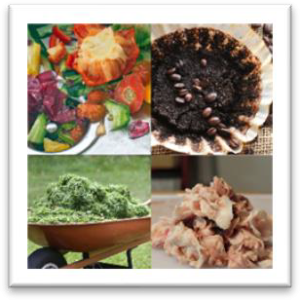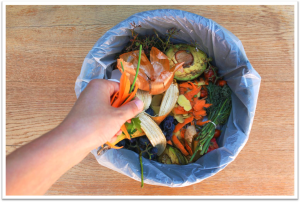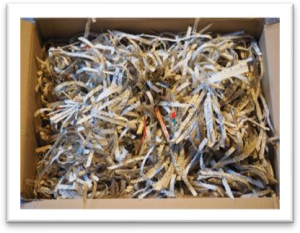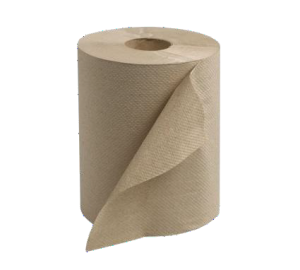3 Composting Concepts
Compost ingredients – Browns, Greens, Water and Air
Browns, Greens, water and air describe the mixture that every Composting system needs in order to breakdown the organic material into finished Compost.
Browns
- Describe the Carbon Rich Materials – These are usually the material that are dry and dead, such as fallen leaves, wood chips or sawdust, paper or cardboard, straw etc…. Typically with Composting Food Scraps you will need two parts of “Browns” or Carbon rich materials to every one part of “Greens” or Nitrogen Rich Materials. This ratio can be adjusted with each compost “recipe” to create the best end product.
Greens
- Describe the Nitrogen Rich Materials – These are usually the materials that are wet and alive, such as food scraps, grass clippings, plant material harvested while it is still alive and manures etc….
The Ratio of Browns to Greens is referred to as the Carbon to Nitrogen Ratio. Typical compost systems require a ratio between 25:1 to 45:1. A link to a Carbon to Nitrogen Ratio Calculator can be found under the additional resources.
Water
- The Composting process is a biological process, and biology needs water to function. Good Moisture Content allows movement of the microorganisms required to breakdown the organic material. Too little water and the Composting process will be very slow or stop entirely. Too much water and the Composting process can become anaerobic (or without air) and slow down or produce offensive odors. The ideal moisture content is between 40 % to 50%, this can be gauged using the squeeze test. If water drips or pours out of the material when squeezed in your hand it is too wet, if the material does not hold a shape and breaks apart when squeezed it is too dry. If the material forms a ball and maximum 1 or 2 droplets of water seep from between your fingers it is at the optimal moisture content for a quick and efficient composting process.
Air
- The microorganisms that are required to break down the organic material and produce an end product that is beneficial to the soil are aerobic (with air) instead of anaerobic (without air). Healthy soil system are aerobic so compost should be too, to enjoy the microbial benefits. Air is incorporated in different ways in different systems. Some systems employ mechanical mixing of the material to incorporate air, some utilize a blower system in order to force air into the material, some utilize chunkier bulking materials such as wood chips to hold air space in the material.
When you are having problems with your Composting system it is a matter of adjusting one of these four areas. A list of Composting problems and their possible solutions can be found in the troubleshooting section of this toolkit.
What can you Compost
Any organic material can be composted. If it was alive once it can be composted.
- Food Scraps (including meat and oils in some Composting systems)
- Coffee Grounds
- Cardboard (not glossy coated cardboard)
- Craft paper
- Used Paper Towels
- Newspaper
- Paper that is not glossy or shiny
- Wooden cutlery
- Straw
- Grass
- Leaves
- Wood Chips, sawdust
- Manures
- Agricultural waste – silage, spoiled grain etc…
Sourcing Other Materials
Food Scraps tend to be what people think of when thinking about Composting. But to make a good compost product “brown material” or carbon rich materials are also needed and can be sourced from internal and external sources. You may be surprised what kinds of “brown materials” are in your building already. Typically, you can find someone or some industry that has a waste product they are more than happy to get rid of.
Some things that you can utilize include:
- Shredded Cardboard – Everything comes in a cardboard box, remove the plastic tape and shred the cardboard for an excellent brown material.
- Shredded Paper – You likely have Shredded Paper in your building already, return it to the Compost system. Note: this is not recommended for outdoor systems, as the shredded paper will blow in the wind. Check the source. Ensure that only paper is shredded. Envelopes with plastic windows, staples or other inorganic material will contaminate the Compost product.
- Fall Leaves – If your landscaping or groundskeepers rake up fall leaves, keep a store of fallen leaves to add to the food scraps.
- Wood Chips – Landscapers and Tree Trimmers will occasionally have wood chips that they cannot utilize. Reach out to your local tree trimmers and have them drop off a load at your site.
- Sawdust – Whether you do woodworking on site or have someone in the office who has a woodworking hobby, collect the sawdust and wood chips for a brown material.

- Paper towels from Bathroom Facilities – Paper towels can be an excellent carbon source for the Composting system. Care must be given to properly label waste receptacles to avoid contamination with regular plastic garbage.
Describe the Carbon Rich Materials. These are usually dry and dead materials such as fallen leaves, wood chips or sawdust, paper or cardboard, straw, etc. Typically with Composting Food Scraps, you will need two parts of “Browns” or Carbon-rich materials to every one part of “Greens” or Nitrogen Rich Materials. This ratio can be adjusted throughout the Composting process to create the best end product.
A natural process that turns organic material into a nutrient-rich soil amendment. The process involves the decomposition of organic matter by microorganisms like bacteria, fungi, and other decomposers.
Substances derived from living organisms or once-living matter. These materials originate from plants, animals, microorganisms, and other living organisms.
The chemical element that is the fundamental building block of life. Carbon-rich material commonly referred to as “browns” includes items like straw, wood chips, sawdust, paper, fall leaves, etc. Carbon is balanced with Nitrogen in the Composting process to transform the raw organic material into the stable humus product recognized as Compost.
Describe the Nitrogen Rich Materials. These are usually wet and alive materials such as food scraps, grass clippings, plant material harvested while still alive, and manures. Typically with Composting Food Scraps, you will need two parts of “Browns” or Carbon-rich materials to every one part of “Greens” or Nitrogen Rich Materials. This ratio can be adjusted throughout the Composting process to create the best end product.
A chemical element crucial for living organisms and plays essential roles in various biological processes, including composting. Nitrogen-rich materials, often referred to as "greens," include items like kitchen scraps, fresh plant material, and manure. Nitrogen is balanced with Carbon in the Composting process to transform the raw organic material into the stable humus product recognized as Compost.
The leftover or discarded portions of food that are not consumed or used.
Refers to the relative proportions of carbon-rich materials to nitrogen-rich materials in a compost pile. For Composting, the ideal Carbon to Nitrogen ratio is around 25:1 to 40:1.
Refers to a biological process or organism that occurs or thrives in the absence of oxygen.
Refers to a biological process or organism that requires or occurs in the presence of oxygen.

